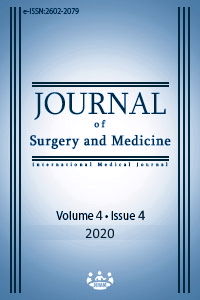The effect on conception rates of bladder fullness during intrauterine insemination: A retrospective cohort study
Keywords:
Bladder fullness;, Conception rate, Intrauterine inseminationAbstract
Aim: Embryo transfer in in-vitro fertilization (IVF) cycles is performed with a full bladder, being careful to avoid surgical instrumentation to the cervix as much as possible, so that uterine contractions are not stimulated. The aim of this study was to investigate whether a full bladder during the application of intrauterine insemination increased pregnancy rates by correcting the cervico-uterine axis, thereby enabling easier access of sperm to the uterine cavity.
Methods: This study included 61 patients undergoing IUI procedures, which were performed on patients with infertility since at least one year and those with at least one open oviduct as seen on hysterosalpingography (HSG). Patients’ demographic data, folliculometry measurements, spermiogram parameters, bladder fullness status on abdominal ultrasonography during the application, and beta hGC levels on the 14th day following the application were recorded from the patient files.
Results: No statistically significant differences were determined between the two groups in terms of demographic data and folliculometry measurements. The conception rate was 20% in the full bladder group, and 12% in the empty bladder group. Tenaculum application was at a statistically significantly higher rate in the empty bladder group than in the full bladder group (P<0.001). The conception rate was insignificantly higher in the full bladder group (P=0.342).
Conclusion: A full bladder facilitates sperm access to the uterine cavity and may increase conception rates. There is a need for further prospective randomized studies with a larger series to obtain better results.
Downloads
References
Hughes EG. The effectiveness of ovulation induction and intrauterine insemination in the treatment of persistent infertility: a meta-analysis. Hum Reprod. 1997;12:1865-72.
Duran HE, Morshedi M, Kruger T, Oehninger S. Intrauterine insemination: A systematic review on determinants of success. Hum Reprod Update. 2002;8:373–84.
Lesny P, Killick SR, Robinson J, Raven G, Maguiness SD. Junctional zone contractions and embryo transfer: is it safe to use a tenaculum? Hum Reprod. 1999;14:2367-70.
Fanchin R, Righini C, Olivennes F, Taylor S, de Ziegler D, Frydman R. Uterine contractions at the time of embryo transfer alter pregnancy rates after in-vitro fertilization. Hum Reprod. 1998;13:1968-74.
Abou-Setta A. Effect of passive uterine straightening during embryo transfer: A systematic review and meta-analysis. Acta Obstet Gynecol Scand. 2007;86:516–22.
Doğanay M, Aksakal O, Dumanlı H, Özakşit G. Urethral catheterisation with abdominal ultrasound in the measurement of residual urine volume after anti-incontinence operation. Jinekoloji-Obstetrik ve Neonatoloji Tıp Dergisi. 2012;8:1354–7.
Tomás C, Tikkinen K, Tuomivaara L, Tapanainen J, Martikainen H. The degree of difficulty of embryo transfer is an independent factor for predicting pregnancy. Hum Reprod. 2002;17:2632–35.
Dorn C, Reinsberg J, Schlebusch H, Prietl G, van der Ven H, Krebs D. Serum oxytocin concentration during embryo transfer procedure. Eur J Obstet Gynecol Reprod Biol. 1999;87:77-80.
Lesny P, Killick SR, Tetlow RL, Robinson J, Maguiness SD. Embryo transfer can we learn anything new from the observation of junctional zone contractions? Hum Reprod. 1998;13:1540-6.
Park KE, Ku SY, Kim H, Jee BC, Suh CS, Kim SH, et al. The use of tenaculum during intrauterine insemination may not affect the pregnancy outcome. Yonsei Med J. 2010;51:949-53.
Nyboe Andersen A, Goossens V, Bhattacharya S, Ferraretti AP, Kupka MS, de Mouzon J, et al. Assisted reproductive technology and intrauterine inseminations in Europe, 2005: results generated from European registers by ESHRE: ESHRE. The European IVF Monitoring Programme (EIM), for the European Society of Human Reproduction and Embryology (ESHRE). Hum Reprod. 2009;24:1267-87.
Balci O, Acar A, Colakoglu MC. Does tenaculum application to the cervix during intrauterine insemination affect pregnancy rates? Acta Obstet Gynecol Scand. 2009;88:1053-6.
Ayas S, Gurbuz A, Ayaz R, Asoglu MR, Selcuk S, Alkan A, et al. Efficacy of passive uterine straightening during intrauterine insemination on pregnancy rates and ease of technique. J Obstet Gynaecol Res. 2012;38:291-6.
Downloads
- 7862 2152
Published
Issue
Section
How to Cite
License
Copyright (c) 2020 Zeyneb Bakacak
This work is licensed under a Creative Commons Attribution-NonCommercial-NoDerivatives 4.0 International License.
















